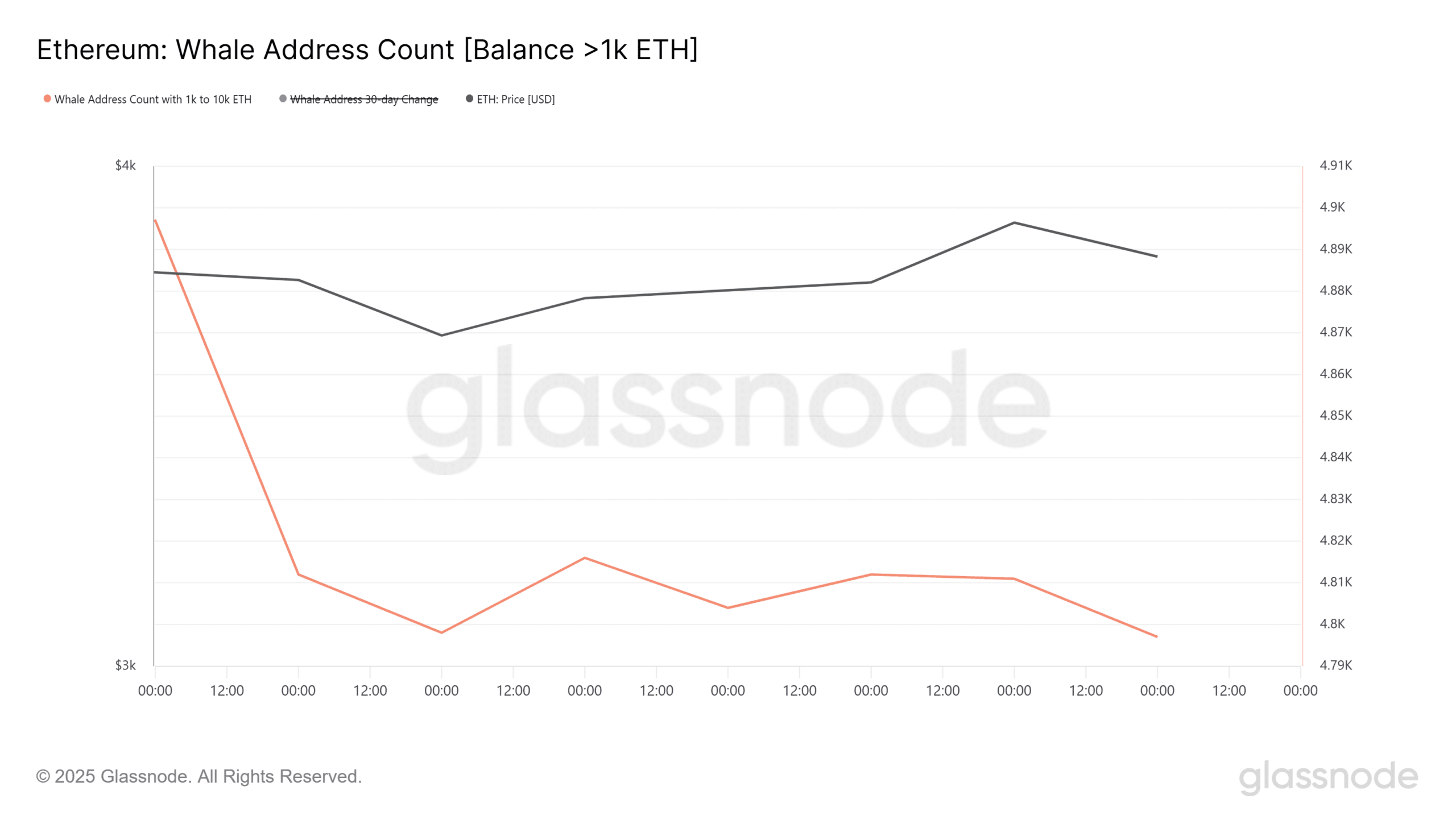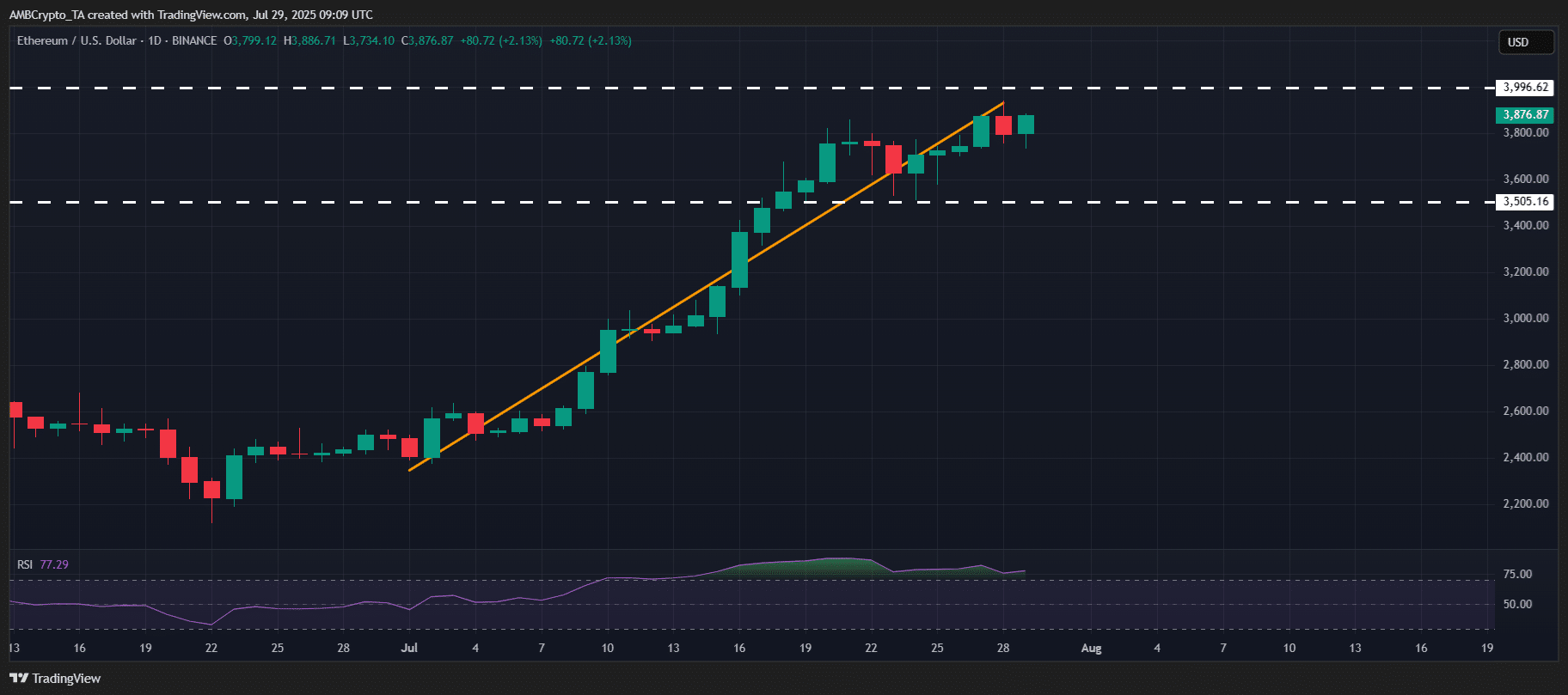Ethereum is currently confined below the $4,000 resistance level due to coordinated whale activity and spot buying patterns, creating repeated liquidation cascades that prevent a sustained breakout.
-
Ethereum’s price action shows a deliberate range bound just under $4K, driven by ETF inflows and shrinking exchange reserves.
-
Whale wallet counts are declining, indicating distribution and strategic short positioning by large holders.
-
Over $100 million in Ethereum longs were liquidated recently, highlighting a cycle of liquidity grabs and failed breakouts.
Ethereum remains boxed under $4K amid whale distribution and macro volatility. Explore the latest market dynamics and what this means for traders.
How Is Ethereum’s Price Range Engineered by Whale Activity?
Ethereum’s price consolidation below $4,000 is not random but appears engineered through significant whale movements and institutional demand. Since July 21, nearly $1.9 billion has flowed into ETH ETFs, while exchange reserves have decreased by 200,000 ETH, tightening supply. Despite this, ETH struggles to surpass the key resistance, currently trading near $3,871.
Additionally, the number of whale wallets holding over 1,000 ETH has dropped by 100 in the past week, signaling a reduction in large holders. This distribution phase aligns with a negative weekly funding rate of -0.21% on Binance, suggesting that perpetual futures traders are increasingly shorting ETH, setting the stage for a coordinated unwind.

Source: Glassnode
What Does the Recent Liquidation Cascade Reveal About Market Sentiment?
Within 24 hours, more than $100 million in Ethereum long positions were liquidated, triggering a sharp price drop. This cascade benefits short sellers and reflects a recurring pattern where late buyers get trapped near resistance. Smart money appears to distribute holdings at the top, accelerating downward moves and reinforcing the cycle of failed breakouts and liquidity grabs.
How Does Macro Volatility Impact Ethereum’s Breakout Potential?
Ethereum is currently trading just 3.3% below the critical $4,000 breakout zone amid growing macroeconomic uncertainty. The upcoming Federal Open Market Committee (FOMC) meeting is expected to influence market sentiment significantly. Meanwhile, ETH/BTC has gained 1.4% intraday, and Bitcoin dominance has slightly cooled to 61.25%, suggesting a potential rotation into Ethereum.
Despite rising spot demand and steady institutional inflows, flipping and sustaining above $4,000 remains challenging. The absence of renewed whale accumulation raises concerns that Ethereum may face a third rejection at this resistance level, prolonging the consolidation phase.

Source: TradingView (ETH/USDT)
Frequently Asked Questions
What factors are causing Ethereum’s repeated rejection near $4,000?
Ethereum’s repeated rejection near $4,000 is driven by whale selling, shrinking exchange reserves, and aggressive short positions in futures markets, creating a cycle of liquidity grabs and failed breakouts.
How can traders anticipate Ethereum’s next move amid current market conditions?
Traders should monitor whale wallet activity, funding rates, and macroeconomic announcements like the FOMC meeting to gauge potential breakout or rejection scenarios for Ethereum.
Key Takeaways
- Whale activity and ETF inflows: Significant institutional demand tightens ETH supply but does not yet push price above $4K.
- Market structure: Coordinated distribution and short positioning create repeated liquidation cascades trapping late buyers.
- Macro catalysts: Upcoming FOMC policy decisions add volatility risks, impacting Ethereum’s breakout potential.
Conclusion
Ethereum’s current price action reflects a carefully engineered range below $4,000, shaped by whale distribution and macroeconomic uncertainty. While institutional demand remains strong, the lack of sustained accumulation by large holders suggests continued volatility ahead. Traders should watch key on-chain metrics and macro events closely to navigate this complex market environment.
